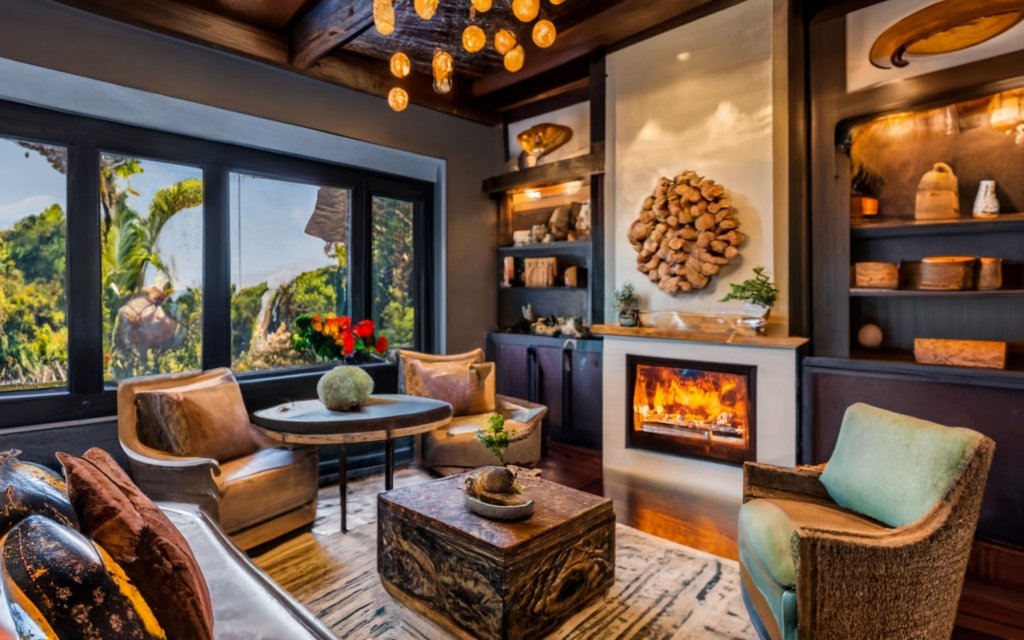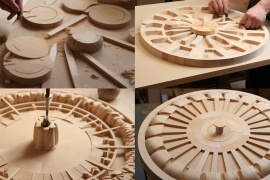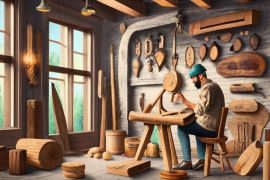The Art of Carving
Crafting customized wooden decor relies on generations-old carving skills and tools while incorporating modern precision techniques. This fusion of traditional craftsmanship and contemporary technology ensures that each piece of wooden decor is aesthetically pleasing, structurally sound, and durable. The mastery of intricate carving, combined with computer-aided design (CAD) and advanced finishing methods, results in timeless and exquisite wooden-themed decor pieces that can transform any space into a work of art.
The History of Carving
The art of woodcarving dates back centuries and was refined across cultures, including Egyptians, Greeks, and indigenous tribes, evolving tools and aesthetic styles. Carving allowed the creation of functional and artful objects from nature’s abundant resources. This intricate craft served practical purposes and showcased the artistic talents of these diverse civilizations, with each culture adding its unique flair and symbolism to the carved creations. Over time, woodcarving has continued to evolve, blending traditional techniques with contemporary design trends, making it a timeless and cherished form of craftsmanship in the world of decor and art.
The Different Types of Carving
Bas-relief carving involves carving figures or designs slightly raised from the background surface, creating a shallow three-dimensional effect. It’s often used in architectural ornamentation and decorative art.
In contrast, sculptural carving typically results in fully three-dimensional, freestanding sculptures. This form of carving allows artists to create intricate and lifelike representations of people, animals, or abstract forms.
On the other hand, Chip carving specializes in creating intricate geometric patterns by removing small chips or pieces of wood from the surface. It’s a precise and delicate form of carving often used in decorative woodworking and folk art traditions.
The Tools of the Trade
Carvers, whether they work with wood, stone, or other materials, rely on traditional and modern tools to bring their creations to life. In addition to axes, adzes, chisels, gouges, v-tools, and mallets, some may also employ specialized instruments like rifflers and rasps to refine intricate contours.
Furthermore, the choice of wood or material can significantly influence carving, as each type offers unique characteristics and challenges. For instance, hardwoods like oak and mahogany may require different tools and techniques than softer woods like pine or cedar.
Finally, the skill and expertise of the carver play a pivotal role in the outcome, as the art of carving demands a deep understanding of the chosen material, the tools used, and a keen eye for detail. It’s a craft that combines tradition with innovation, resulting in beautifully carved works of art.
Techniques for Carving Wooden Decor
In addition to these techniques, master carvers often employ a deep understanding of wood grain patterns to enhance their creations. They carefully select wood species that complement their artistic vision, considering factors such as colour, hardness, and texture. Furthermore, the skilful use of chisels, gouges, and specialized carving tools allows them to achieve intricate details and bring life to their wooden masterpieces. These craftsmen transform wood and infuse it with a unique blend of craftsmanship and artistry that makes each piece an actual work of art.
The Role of Sanding and Finishing
Sanding refines the carved decor piece into a cohesive, smoothed final form ready for finishing. Careful finishing seals and protects the wood while enhancing grain patterns and colours.
The Benefits of Customized Wooden Decor
Infusing personalized details into wooden decor provides more profound meaning and connection.
Personalization and Uniqueness
Customizing wooden decor makes each item one-of-a-kind. Personalized details like monograms resonate more meaningfully than generic pieces.
Aesthetic Appeal and Warmth
Carving introduces ornate shapes, textures, and negative spaces that interact beautifully with the natural woodgrain patterns to create visual interest and charm.
Emotional Connection and Sentimentality
Seeing personalized engravings, shapes, or phrases on wooden decor evokes fond memories, nostalgia, and a sense of legacy with every glance.
Versatility and Adaptability
Customized carving adapts wooden decor to match clients’ spaces, allowing hand-picking boards to complement surroundings.
Health Benefits and Well-Being
Displaying meaningful customized wood pieces provides mental and emotional uplift, lowers anxiety, and promotes mindfulness daily.
The Types of Customized Wooden Decor
Carving personalizes furniture, wall art, figurines, frames, signs, boxes, and more wooden items.
Personalized Wooden Signs
Signs and plaques engraved with family names, inspirational quotes, or designs make meaningful displayed mementoes.
Customized Wooden Picture Frames
Carved frames customized with ornate edges, shapes, and engraving showcase treasured memories while accenting decor.
Carved Wooden Furniture
Texturing, shaping, and embellishing functional furniture like beds and shelves create personalized flair.
Engraved Wooden Plaques
Plaques etched with imagery and lettering commemorate momentous life events, achievements, or sentiments.
Hand-Carved Wooden Figurines
Artisans hand sculpt miniature figures of pets, people, mythical creatures, and carved keepsakes.
The Process of Customizing Wooden Decor
Creating quality customized wooden art involves careful design, carving, and inspection.
Choosing the Right Piece of Wood
The wood species, size, grain patterns, and natural flaws dictate the forms suitable to the client’s vision for customization.
Designing the Customized Wooden Decor
Sketches incorporating the personalization details map out the decorative carving approach. Computer-aided design modernizes planning.
The Role of Computer-Aided Design (CAD)
CAD software allows the previewing of personalized concepts virtually during design before carving begins. Clients can request revisions digitally.
The Carving Process
Artisans transform wood with detail chisels, rotary bits, pyrography pens, v-tools, and sanding into one-of-a-kind creations reflecting clients’ custom requests.
Quality Control and Inspection
Carvers verify dimensions, joinery strength, personalization accuracy, smoothness, and safety at each step to deliver quality experiences.
The Comparison of Different Types of Wood for Carving
Natural properties make certain woods better choices for particular carving needs.
Hardwood vs. Softwood
Hardwoods like oak better withstand carving details but are more challenging to work. Softwoods like pine carve easily but lack strength.
Oak vs. Pine
Oak’s bold grain patterns add rustic beauty but require diligent sanding and sealing. Pine dents quickly but accepts details well.
Mahogany vs. Cherry
Rich reddish mahogany carves consistently for refined detailing. Delicate cherry finishes beautifully, but Mars is rushed.
Maple vs. Walnut
Maple’s hardness challenges details but takes stain well. Softer walnut cuts smoothly yet can splinter if carved too aggressively.
Cedar vs. Redwood
Aromatic rot-resistant cedar suits outdoor carvings with knots. Redwood’s tight grain holds intricate embellishments but needs preservatives.
| Wood Type | Hardness Rating | Grain Pattern | Workability | Common Uses |
| Basswood | Soft | Fine and Even | Very Easy | Detailed carving, sculptures |
| Cedar | Soft | Straight | Easy | Outdoor carvings, relief |
| Cherry | Hard | Fine and Uniform | Moderate | Furniture, decorative items |
| Walnut | Hard | Fine and Straight | Moderate | Fine carvings, furniture |
| Oak | Hard | Prominent Rings | Moderate | Furniture, architectural |
| Maple | Hard | Fine and Uniform | Moderate | Furniture, utensils, bowls |
| Mahogany | Hard | Interlocked | Moderate | Furniture, musical instruments |
| Pine | Soft | Straight | Very Easy | Decorative carvings, signs |
| Redwood | Soft | Straight | Easy | Outdoor carvings, signs |
| Ebony | Very Hard | Fine and Uniform | Difficult | Fine art carvings, inlays |
Conclusion
Infusing personalized meaning into functional wooden objects satisfies humans’ innate urge to embellish and improve upon nature’s raw gifts. The endless carving possibilities allow imbuing family memories, cultural symbols, or loving messages into unique decor that showcases skilful artistry. From the first pencil sketch incorporating clients’ valued ideas to the final sanded engraving sealed and delivered, customized carved decor connects on emotional levels store-bought pieces cannot replicate. Artisans’ most profound reward comes from playing a small role in enriching others’ spaces with daily inspiration through their wooden handiwork.



